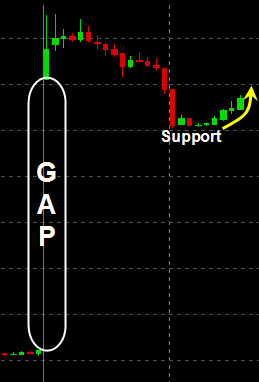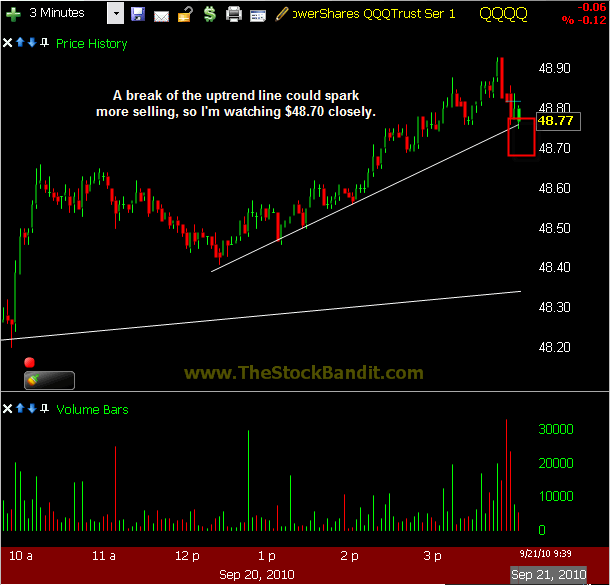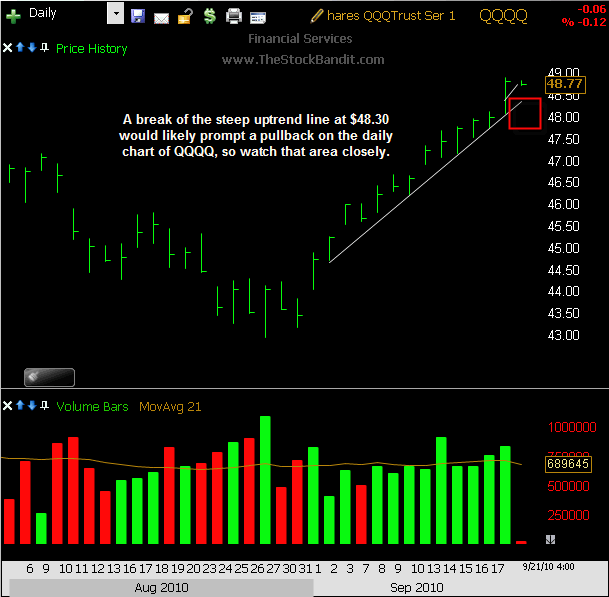Search Results for 'traders'
One Intraday Setup That’s Working
In a world dominated by algo’s and machines, the astute trader can still turn a profit. It’s true, despite what many losing traders might tell you.
It takes adaptation, some ingenuity, imagination, and of course, thinking outside the box. For the creative trader though, new patterns will emerge from which profitable trades can be made.
So today, I wanted to point out to you one such example. I won’t name the stock, because it doesn’t matter, but here’s the chart from the opening 50 minutes or so:
As you can see, this stock gapped higher, ran a little more initially, and then began to roll over. The selling intensified as new lows were made on the session, and the gap began to fill before a brief period of rest set in. But that wasn’t the end of the story. Conventional day trading wisdom says this gap keeps getting filled, but only if another new low is made with a break of that intraday support.
Lately I’ve noticed this kind of setup – and you can reverse it with a downside gap if you’d like – offering some good plays. I had one finger on the trigger to short sell this one upon a break of that support, but it held just above the whole number. As the stock started to catch a bid, I went long with a very tight stop – only $0.06 from my long entry. And only 10 minutes later I was flipping out my shares for a quick $0.50 winner.
** For those wondering, that’s a reward-to-risk ratio of better than 8:1.
This setup offers two things I really like…
First, it offers very minimal, defined risk. If support (or resistance in the case of a morning gap down) gives way, I’m out quick for a small loss.
Second, it offers a great pivot area where emotion is building. The battle that took place at support was really something, and once one side began to win out (in this case the buyers), it sparked a quick move away from that level.
So, keep an eye out for this setup – it’s been a great one to trade. Gaps which only partially fill before hesitating at a level just might offer you a quick, profitable reversal play like this one.
Trade Like a Bandit!
Jeff White
Producer of The Bandit Broadcast
Are you following me on Twitter yet?
Are Sellers Looking for a Catalyst?
Anytime we see market streaks emerge, we know someone’s been caught on the wrong side.
Monday’s session marked the 12th advance in the previous 13 trading sessions for the NAZ, including nine straight. Breakouts happened across the board, with the summer highs being cleared on solid volume. It almost feels like stocks may never decline again – and that’s a dangerous way to think.
The market will humble traders of all kinds, including bulls who become overconfident. It may not be a life-altering lesson, but in a tape like this, it could be one slip that brings a sudden pullback – even if it’s a brief one.
The technical picture is positive, there’s no doubt about it. We just established higher lows in August relative to July, and we just made higher highs. That’s a shift of trend, not only in the short term of the past couple weeks, but in the intermediate term of the past few months. The bulls are sitting pretty.
Things start to get really tricky though when momentum begins to run a little too hot, which is where we are right now. All news has been good news of late, and the buyers have dumped cash into this market relentlessly since the start of September. It’s been an impressive run, no matter how you slice it.
For a reality check, however, it’s safe to say that all the easy money has been made for this run. The pace is unsustainable, plain and simple. We could push higher from here, there’s no rule to prevent that from happening, but it’s far more likely that we’ll see some profit-taking kick in sooner rather than later. Those who are sitting on profits will be quick to lock them in at the first sign of weakness.
When it comes to excuses, the market is excellent at finding them. Right now, my hunch is that the bulls are needing an excuse to satisfy their urge to lock in at least some of their gains. And with a few key events on the horizon, it’s important that you and I stay on our toes.
Today’s FOMC meeting may be the first possible excuse for some profit-taking. It may not even matter what the Fed does or says – what matters is how the market responds to the news. And if it isn’t today, then there’s plenty of economic news slated for this week which could prove to be a market-mover.
So, I’m on the watch for a possible pullback. If I were predicting, I’d already be short – and I’m not. Instead, I’m watching carefully to see if some selling kicks in, which would then set up a favorable risk/reward scenario for a little round of selling. Here’s my game plan:
The QQQQ has rallied big, not only in recent weeks, but on the intraday chart as well. We have steep uptrend lines on both the daily and intraday charts, and I’m watching them both for downside breaks. First, let’s take a look at the intraday chart. Monday’s advance was smooth, and a break of the rising trend line at $48.70 would likely spark some selling. I’ll go short there with a stop in the $49 area, just above yesterday’s high.
On the daily chart, there’s also a steep rising trend line. A break of that wouldn’t necessarily mean price goes straight down, but it may be a worthwhile short for the nimble to catch the first move. The rising trend line currently stands around $48.30, and a break of that level could bring into play a multi-day pullback. Traders watching the daily chart should keep that level front and center today, and it will climb daily should this market happen to continue advancing. Once it’s broken though, the move could be a swift one to the downside for a quick trade.
Trade Like a Bandit!
Jeff White
Producer of The Bandit Broadcast
Why I’m Buying Financial Sector ETF’s
Financial stocks have been hideous. Banks, brokers, you name it and it’s been taking it on the chin lately. Shorts are getting cocky.
What’s so interesting though is that, like the market, many of these stocks have a shot at establishing a higher low on their daily charts relative to the July low – if this pullback finds buyers.
 I should clarify, I was once told that “IF” is a really big word for only 2 letters. That’s true, but let’s look at the financial sector ETF’s, starting with XLF.
I should clarify, I was once told that “IF” is a really big word for only 2 letters. That’s true, but let’s look at the financial sector ETF’s, starting with XLF.
By the way, the points stated below also apply to FAS and UYG, which I’ll review as well.
As a technician, I realize perfection isn’t to be expected when looking at a chart. Algorithms and savvy traders alike recognize that the head fake breakout or breakdown can be a fabulous way to establish reversal positions. And this is one such candidate.
With the July 1st low of $13.34 getting broken by a nickel just last week, XLF has stabilized (for now anyway). I like that for a few reasons…
- First, it shook out some traders on that ‘breakdown’ through support.
- Second, it’s frustrating those who got short on the break, providing no follow through yet.
- Third, there’s a downtrend line just overhead which was established throughout August, which if crossed, would provide another technical reason for buyers to enter (or re-enter) the picture.
That leaves 3 potential trader types as would-be buyers if an advance begins…
- Shorts would need to cover.
- Shaken-out longs would want to re-enter.
- New longs would want to establish positions.
So there is some appeal here, on both technical and psychological grounds. Well-defined pivots like this from key zones can produce explosive moves – particularly when multiple groups of traders may be poorly positioned.
The Plan
With XLF churning over 70 million shares on an average day, this thing is not a fast mover. Plus, it’s range-bound with the $15 zone offering formidable resistance over the past 3+ months.
I’m establishing a long position at current levels with an initial stop stop in the $13.20 area (1/2 position beneath last week’s low), and a final stop just beneath the $13 level. That would be favorably offset with a potential move back up to the $15 neighborhood where key resistance resides.
The aforementioned $13 zone offered a multi-month peak back in May of 2009, and there’s an unfilled breakaway gap from August 2009 which could get filled on a continued slide from here. So, I view that as an adequate loss-cut area for this trade.
If this thing is able to gather some traction, I’ll then lighten and tighten (peel off pieces on the way up and adjust my stop accordingly). I’m expecting to be in it for a few weeks if it works, so I’ll be patient along the way.
Here’s a closer look at the XLF chart for you:
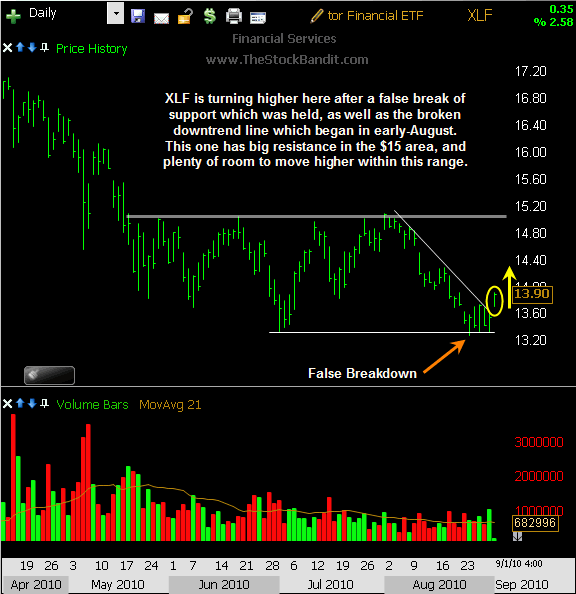
Not to be forgotten are the leveraged ETF’s, which offer more bang for the buck. UYG is the Proshares Financial ETF, which is essentially the 2x levered version of XLF. Using the same rationale, I’m looking for UYG to return to the $58.50 resistance area while using a stop of $46 should support happen to get broken solidly.
Here’s a closer look at the UYG chart for you:
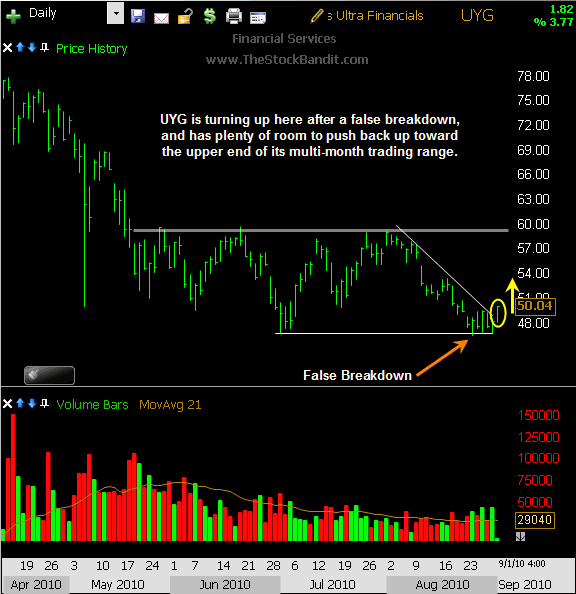
Finally, the title of “most slippery” of the levered financial sector ETF’s goes to FAS, which is the Direxion Financial Bull, which is 3x the movement you’d expect to see in XLF. Like the other charts, I’m looking for FAS to return to resistance, which is in the $24 area. Should it happen to break down, a gap fill from August 2009 down to the $16.50 area would be my cue to exit.
Here’s a closer look at the FAS chart for you:
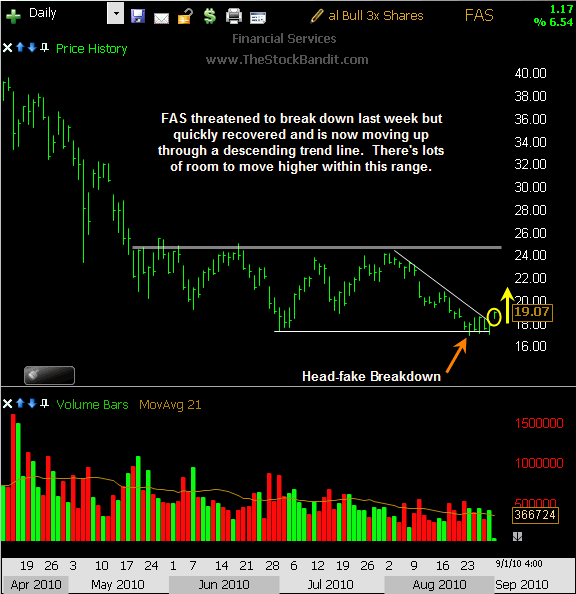
Trade Like a Bandit!
Jeff White
Producer of The Bandit Broadcast
Are you following me on Twitter yet?
15 Questions & Answers
My recent live interview with Charles Kirk generated quite a few questions. A number of them we were able to address during the chat, but many went unanswered.
If you were in attendance and didn’t get your question answered, look for it below. But even if you weren’t there, hopefully you’ll find this useful to observe. I’m also happy to answer questions via the comments section below, so feel free to post yours there!
Here are 15 unanswered questions from the session:
1. Kevin: Jeff, what timeframe do you normally use in your charts, and do you let the bar close before entering a trade?
- Thanks for your question Kevin. I focus on the daily charts for swing trades, and the 3-minute charts for day trades. I don’t wait for the bar to close before entering a trade. That might save me an occasional failed signal, but I feel it will cost me many other trades which work right from the start, so for me it’s worth taking my entries as they signal.
2. Ryan: Do you have any execution techniques that you like to use?
- Hi Ryan! I like to keep things really simple, so I use basic stops for entries and exiting losing trades. That way, once a level has been crossed, a market order is generated immediately and I’m in (or out of) the trade. I’ve tried to get cute in the past with more complicated orders or execution techniques, but in the end it made me no more money and often cost me opportunity (buying breakouts with a limit order, for example, as the stock never looks back). When I’m booking profits, I’ll use limit orders at my targets and let the stock come up and hit me, but that’s the only time I utilize them.
3. Moe: How can you scan the market for setups or make trades when the market is so volatile and so driven by daily events and emotions?
- Yes Moe, it truly is a news-driven environment right now, and it might be that way for a while. I think the key is recognizing that I’m not trying to get in front of any news or predict what news may come along. Instead, I’m looking to put capital at risk when there’s an expected reward, and in order to do that I need to be hitting the charts regularly. Training your eye to do that will always leave you with opportunity, whereas waiting for emotions to settle could leave you sidelined possibly forever. Remember, that emotion and volatility brings with it opportunity. On the flip side, a trendless market with nothing but uncertainty brings with it very little opportunity. Keep looking for trades, and keep your capital moving.
4. Guest: What sectors are you finding most of your trades these days?
- Hello and thanks for your question. In terms of swing trades, I’ve traded many sectors and there really has been no consistency there to speak of. When the right patterns emerge, I take the trades. In terms of day trading though, I’ve focused frequently on the ags, financials, and energy names quite a bit in recent weeks, as they’ve been in play regularly.
5. Jon: Isn’t the general rule of thumb that in a correlation study, most of the correlation comes from selection, then overall market, so what we are looking for in trading is the small fraction which lead the pack on a given day which will then beat just trading the index ETF’s?
- Hi Jon, the recent discussion of being in a highly-correlated market (to the S&P 500, for example) carries with it some weight, yes. And I do agree that what we’re after is to locate leaders and trade them instead of the ETF’s. Keep in mind though that there will always be outliers which exhibit extreme strength or weakness, and those carry with them some real potential for good trades. So, seek out momentum whenever possible, and you should find far better bang for your buck vs. the ETF’s.
6. Sam: Do you ever trade options?
- Hey Sam, I do trade them on occasion. In longer-term accounts, I’ll short puts to establish long positions, then sell calls to collect premium. I don’t do a lot though in terms of directional trading with options. Occasionally when a stock looks to be very high risk, such as BP recently, I’d rather hold options overnight than common, simply to have defined, limited risk. The rest of the time, I’d rather have the shares for the greater liquidity, less slippage, and more flexibility to trade extended hours or pre-market (if necessary).
7. Tom: Do you hold stocks into their earnings report or do you only trade following the report?
- Hi Tom, actually I never want to hold a stock into an earnings announcement. Being a technical trader, it’s important for me that I can use the price action to determine both my entries and exits. That’s technical. When it comes to an earnings announcement, we’re talking about a major fundamental event, and since those usually happen outside market hours, I can’t control my risk. The stock is so likely to gap big after that news that I might have no shot at closing the trade at my planned exit. The excitement of potential ‘free money’ lures many traders into acting on their hunch, but it’s simply a coin toss and I am not about that with my trading. So, I want to stay responsible and only take trades where I expect to be able to manage my risk appropriately.
8. Frenchy: What is your favorite ETF you like to trade?
- Hi Frenchy. When it comes to the main index ETF’s, I like the usual SPY, QQQQ, and IWM. Typically I’ll avoid DIA since it’s only 30 stocks, and that can complicate matters more. In terms of leveraged ETF’s, I’ll go with SSO/SDS, QLD/QID, and TWM/UWM. Those are double exposure, and while there are some triple exposure ETF’s out there, I find the 2x levered funds are enough to provide nice moves.
9. Leon: Do you believe a high volume move to the downside can be a reversal signal?
- Hello Leon, that’s a good question. The short answer is yes, but it depends on how it happens. A stock which has been in a parabolic uptrend will sometimes signal exhaustion in this manner, reversing to the downside on heavy volume. Often, that’s followed by additional weakness. However, a stock that’s range-bound which sees a high-volume decline on a given day may see no downside follow through. So it can happen, but I’d be careful not to put a blanket statement across all high-volume selloffs that they’re reversal signals.
10. Jon: Do you feel price follows volume, or volume follows price?
- Hi Jon, this is a real chicken-and-the-egg topic, and there are cases of both. For example, consider a stock in a pattern like a bull flag. Price is consolidating, but one day edges toward upper resistance on heavy volume. That will many times signal an impending breakout, so volume in that case tends to lead the way. In other cases, price begins to gain momentum, and as the stock gets more attention, the volume naturally increases (following the move in price). See CAGC in recent weeks for an example of this. So it can happen either way. Nonetheless, I care the most about price, so if I’m seeing volume kick in ahead of a breakout, for example, I’ll still want to see price confirm that before I look to make an entry. That keeps me sidelined until I believe a real move is starting. Just remember, price is of utmost importance. If you’re on the wrong side of a move, it doesn’t matter if the volume is heavy or not, it’s still going to hurt!
11. Ryan: Do you have any interesting research projects in the works?
- Hi Ryan, actually I just recently completed a huge project with the creation of the Advanced Trading Course over at TheStockBandit University. That was a major project and I put everything I know into that course, so I don’t plan to do any other big projects for a while.
12. Layne: What indicators do you like to use? Certain ones in certain markets?
- That’s a great question Layne. I should say right up front I don’t rely on any indicators across the board, and actually utilize them rather infrequently. However, there are times when they can help in the trading process, so I’ll put them on the chart when it’s appropriate. A moving average, for example, is really only helpful in a trending market. I just put out a post explaining how and when to use moving averages. I will sometimes add ATR to my chart to see just how much (or how little) movement there’s been lately, and that’s another one which has been helpful for me. If anything, the ATR value lets me know when there’s just not enough movement to offer real potential relative to the risk I’d be taking.
13. Jake: What are the setups that you look for on the chart before buying and selling?
- Hi Jake, first I’m going to look for the presence of a trend. If there isn’t one, I’ll take a completely different approach in terms of what types of patterns I’ll look for. If there is a trend, then I’ll be watching for continuation setups like flag patterns, pennant patterns, and triangle patterns. And along with the price patterns, it’s important that the volume activity is confirming the price action, so I monitor that closely as well. Taking note of the rhythm of a trend is another key element, as it helps me gauge whether I should focus more on breakout patterns or utilizing pullbacks to get on board. There are a ton of ways to skin the market cat, but I’ve found it most effective to adjust to the environment you’re in rather than forcing one particular style at all times.
14. Ryan: Do you see the growing awareness and popularity of ‘technical analysis’ translating into an easier market to trade in the future, or a more unpredictable one as more retail money uses the same methods?
- Hello Ryan, another excellent question. Technical Analysis 101 has certainly become more embraced by retail traders than it was even a few years ago, but my response to that is somewhat complicated. First of all, I don’t think there’s a uniform usage of technical analysis methods across retail traders. Take 10 traders and ask them to define a particular pattern, or ask when they should use a particular indicator, and you’re likely to get a variety of answers. So that’s one issue I think that keeps everyone from seeing the exact same patterns or acting on them at the exact same time. Another issue is a bit more vague, which is the program trading we’ve seen such a growing amount of in recent years. Computer algorithms are likely preventing some patterns from fully maturing, or the institutional money heavily fades a breakout, causing many retail traders with tight stops to dump shares, only to see the stock head right back up. So it can be pretty tricky out there, and for those reasons, I do not think the rise of Technical Analysis has resulted in an easier market to trade. Bottom line is, ‘they’ will never make it easy. You and I have to keep paying attention to what’s working and what isn’t, and do more of that which is working!
15. Guest: Have there been any patterns you’re finding that are working well in this environment?
- Thanks for your question, and yes there are. I’ve focused more on trading the rising and falling wedges, as well as the “tilted” trend line breaks (like ascending or descending trend line breaks) for swing trading. For day trading, I’ve looked more for those exhaustion moves where news has caused an overreaction and the stock needs to come back in, so those are the ones I’d say have been most profitable to me in recent months. I also detail the most profitable one in the Advanced Trading Course. The key is to remember that what’s working well right now will eventually morph into something else, so we have to stay on our toes and be willing (and able) to adjust when conditions deem it necessary.
Trade Like a Bandit!
Jeff White
Producer of The Bandit Broadcast
Are you following me on Twitter yet?
How and When to Use Moving Averages
Price action provides me with chart patterns to trade from, and usually, that’s enough. However, occasionally I’ll see a situation where adding a basic indicator can really help out.
Many traders rely heavily on indicators, and while it’s my style to keep my charts nearly bare, indicators can be helpful. I think where traders tend to get into trouble is when they rely solely on the indicators, rather than seeing how they confirm or deny the overall price action.
 If you’re looking for a one-size-fits-all indicator to rely on in all market conditions, or which all stocks will respect, you’re going to be looking for a very long time! However, if you’re willing to learn when, why, and how to apply indicators to your charts, they can be an aid to your trading process.
If you’re looking for a one-size-fits-all indicator to rely on in all market conditions, or which all stocks will respect, you’re going to be looking for a very long time! However, if you’re willing to learn when, why, and how to apply indicators to your charts, they can be an aid to your trading process.
In this post, I want to show you how and when I use moving averages when eyeing potential trades. It’s a very basic indicator, but when there’s a trend present, it can help you gauge momentum, as well as help you decide on entries and exits.
Let me suggest going full-screen with the ‘HD’ option for best quality in the video.
Trade Like a Bandit!
Jeff White
Producer of The Bandit Broadcast
Are you following me on Twitter yet?
Ashland Still Has Room
We’ve seen persistent strength in this market since the July 1st low, and while the long side has been the one to trade on, it’s still important not to chase extended names.
Fortunately, looking through hundreds of charts each day can still yield several opportunities, particularly if you know what to watch for. Too many traders fail to recognize the value of rest for a stock, and if it hasn’t moved in several days they tend to forget about it. My take is that those rest phases can be the pause that refreshes, especially if there’s been some recent momentum present.
Today I’m bringing you one such stock. It’s been climbing very well since turning the corner several weeks ago, and has also done an excellent job of digesting advances with these rest phases. There’s still some room for this one in the short term, so it’s on my radar.
I’m watching ASH for a push through short-term resistance at $53.10 for a trade. One higher low has already been established, and the stock has been basing for the past 8 sessions after a solid advance. This one looks like it may make a push toward the downtrend line which has been in place since April, which also offers a logical spot to book gains (if reached) in the $55.50 area.
Here’s a closer look for you:
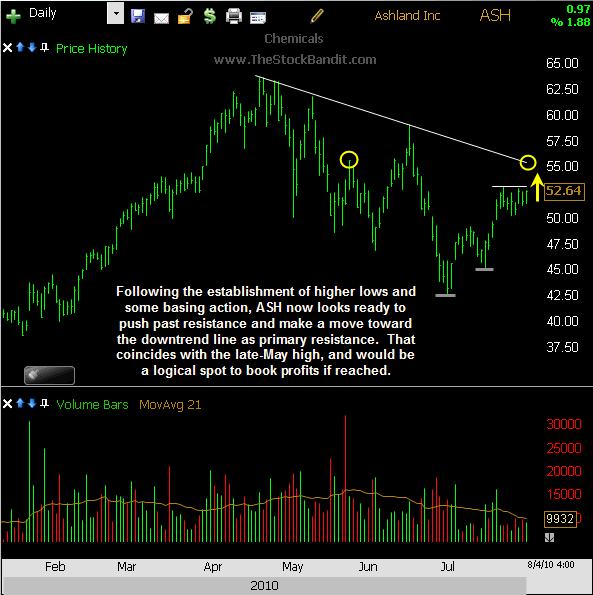
Trade Like a Bandit!
Jeff White
Swing Trading & Day Trading Service
www.TheStockBandit.com
Are you following me on Twitter yet?
Homebuilder Stocks on Solid Foundations
The stock market is often times simply a market of stocks, meaning that it’s necessary to sift through them all in order to find some which appear tradeable.
Occasionally though, we notice sectors moving in tandem, giving us multiple opportunities in the same group. That sometimes gives us a chance to identify leaders and laggards, while other times it shows us greater confirmation that something is developing.
Right now is one of those times for the stocks of homebuilders.
Most of them have similar chart patterns, which is the rounded bottom pattern (or rounded low), and they’re setting up to confirm bullish reversals in the coming weeks and months.
The (Floor) Plan
Moves which are expected to take up to a couple of months is a longer timeframe than I generally tend to trade, but the nature of this pattern is such that it should take longer to play out. So, my plan in trading these is to establish small positions, add to them upon further technical evidence of a trend shift, and manage them as position trades. Because I’m an active trader and expect these to work over the course of a couple of months, I don’t want them on my screen every day. As a result, I’ll be utilizing long-term retirement accounts as the ‘home’ for these homebuilders.
Keep in mind, I’ll be maintaining protective stops just in case these patterns don’t pan out, and I will be starting small and looking to add later. But the technical foundations are there for these longer-term patterns to play out, and I like the risk/reward they’re offering.
Here’s a quick rundown of several I’m seeing…
LEN trended lower from its April price spike to fill a gap from January, which is technically healthy. In recent weeks, the downtrend has stalled as price is stabilizing just beneath resistance:
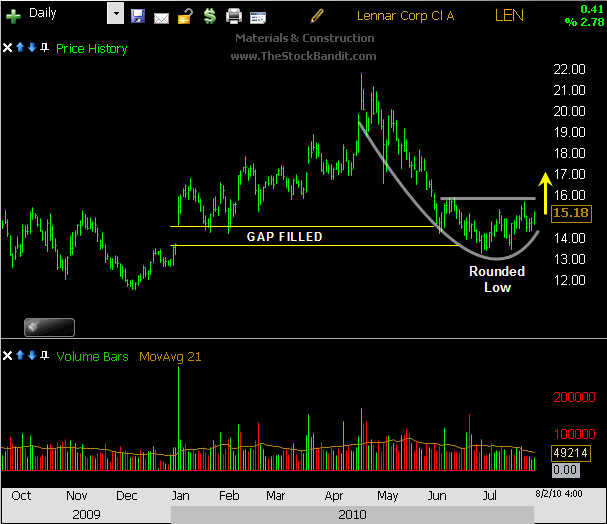
DHI pulled back enough to take out its December 2009 low, and not by much. That kind of move often shakes out some traders who will now likely add to the strength by jumping back on board if this rounded low pattern is confirmed:
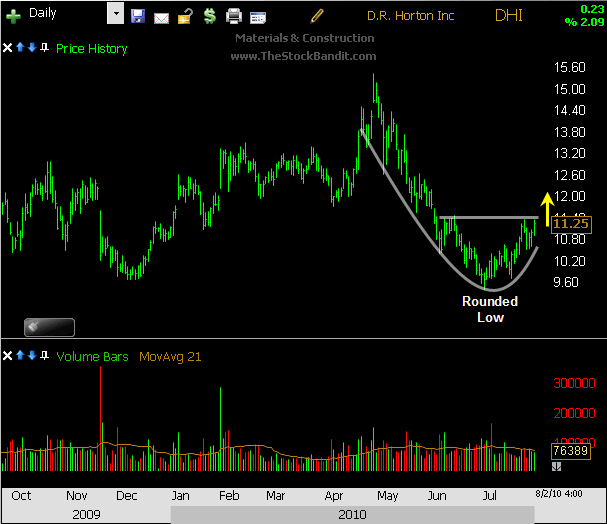
HOV briefly undercut support from early this year on its latest selloff, which was a nasty 57% correction. Price has stabilized in recent weeks with some short-term higher lows, and this one still has plenty of room to rally:
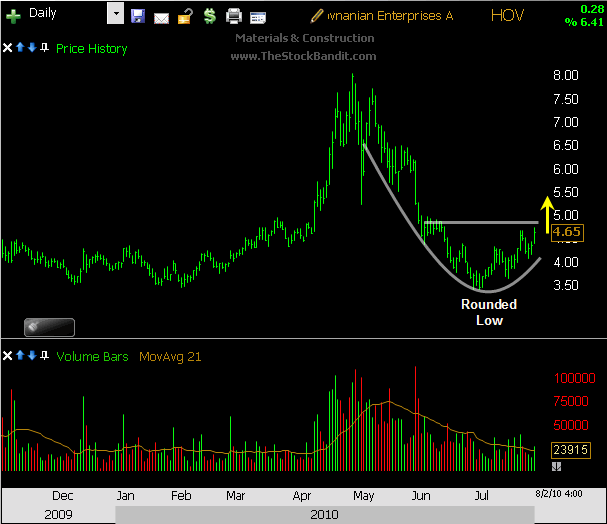
PHM trended persistently lower after topping in late-April, and two positive things have happened since then. First, the decline has made no progress in 2 weeks. Second, a rounded low is in place, which if confirmed, could ignite a solid push higher as this one retraces at least a portion of the May-July selloff:
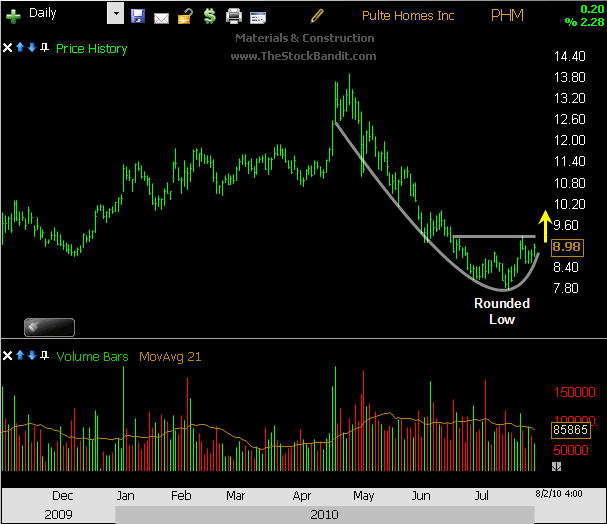
RYL sold off sharply from its April highs, but for the past several weeks, price has stabilized and established support. A move up through resistance would set this stock on the path toward higher prices:
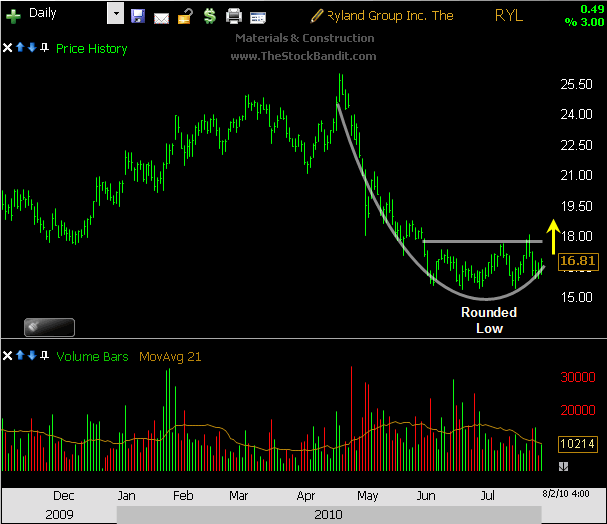
MTH has found recent support after a big correction, and here again, the rounded low would be confirmed with a move up through resistance:
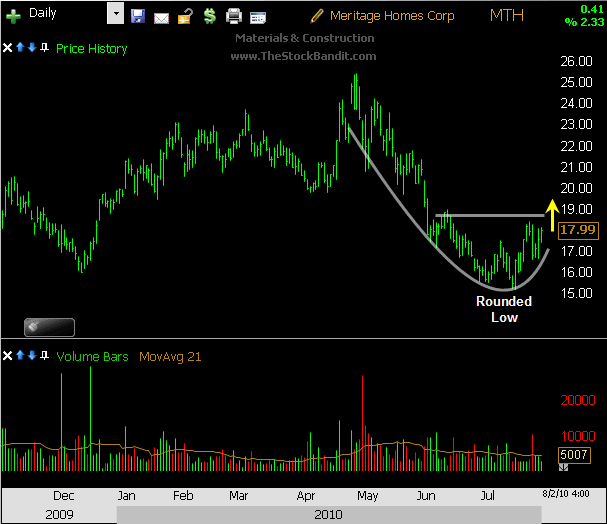
KBH was cut in half from its April peak to July low, and in recent weeks has carved out support. Price is now beginning to curl higher, and a move through resistance would confirm that:
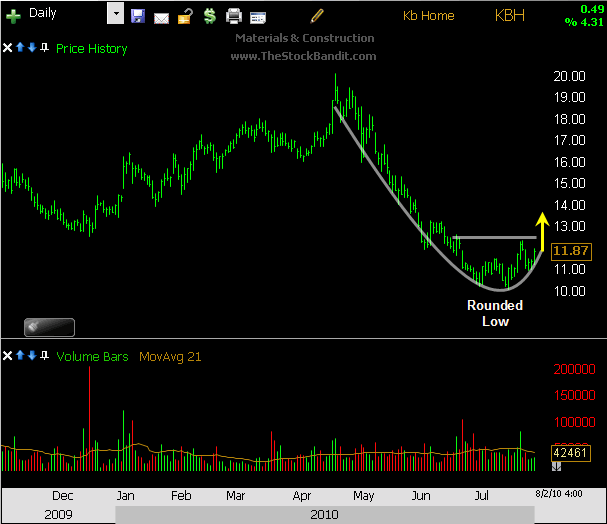
SPF gave up 58% during its harsh selloff between April and July, but now is gaining strength and looking to accelerate higher if resistance is cleared:
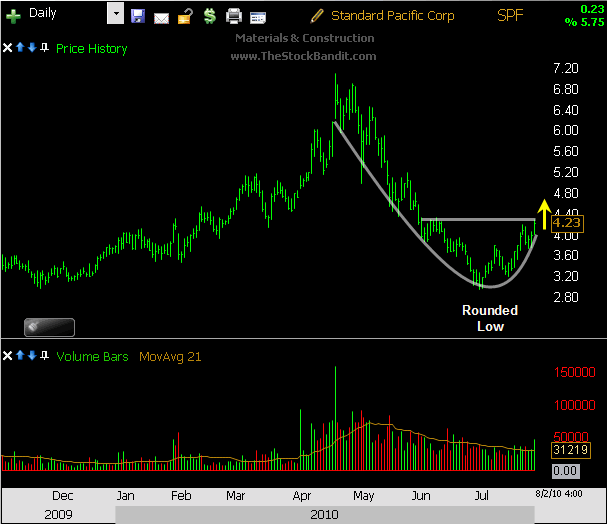
Finally, TOL is looking good after finding support in July and creating some short-term higher lows in recent weeks. A push through resistance would free up this stock for higher prices as well:
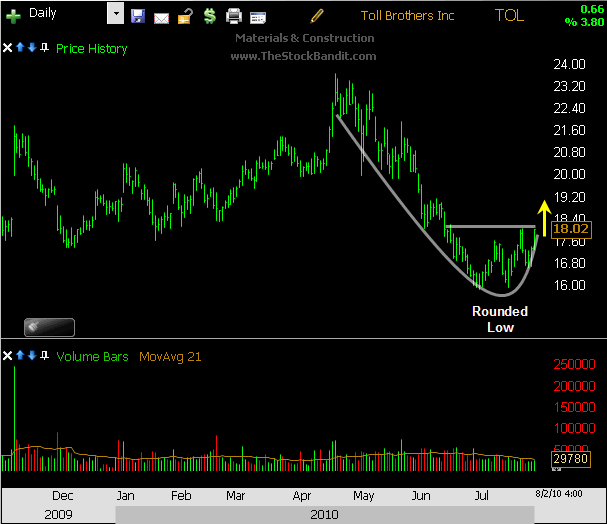
Trade Like a Bandit!
Jeff White
Swing Trading & Day Trading Service
www.TheStockBandit.com
Are you following me on Twitter yet?


